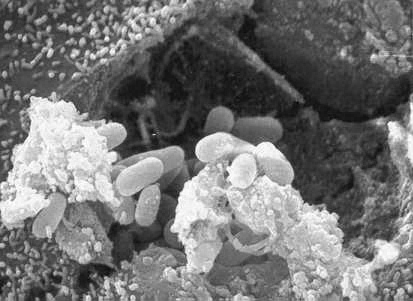Encephalitozoon hellem
A Microbial Biorealm page on the genus Encephalitozoon hellem

Classification
Higher order taxa
Superkingdom, Kingdom, Phylum, Suborder, Family, Genus:
Eukaryota, Fungi, Microsporidia, Apansporoblastina, Unikaryonidae, Encephalitozoon
Species
Encephalitozoon hellem
Description and significance
Encephalitozoon hellem was initially dectected and isolated in 1991 from three AIDS patients who were suffering from keratoconjunctivitis among other ailments. Conjunctival scrapings and corneal tissue samples were taken from each of the three patients and were tested using SDS-PAGE analysis and Western Blotting4. All three isolates had identical banding patterns and appeared similar to but another species of Encephalitozoon, E. cuniculi, and the new AIDS related microsporidian was then given its name, Encephaliozoon hellem.
In 1995, another AIDS patient experiencing a foreign body sensation in his left eye had a conjunctival swab tested using a calcoflour stain and a fluorescent-antibody stain with murein antiserum raised against E. hellem. A cross-reaction occured with another species of Encephalitozoon, so a PCR test was performed. It was found that the amplified rRNA generated digestion patterns by restriction endonuclease FokI that were indentical to the digestion patterns of E. hellem 3. These observations allowed researchers to conclude that Encephalitozoon hellem causes keratoconjunctivitis in addition to other disseminated infections in immunosuppressed patients. Doctors and researchers soon found that patients treated with albendazole and topical fumagillin responded rapidly with no opthalmologic signs 3.
Encephalitozoon hellem is a unicellular microsporidian that is thought to often be fecal borne. It is a spore forming parasite whose spores measure approximately 1x1.5-2.0 microns in diameter 4. E. hellem had been named one of the four most common human microsporidian parasites, with its human hosts consisting mainly of immunodificient patients.
Genome structure
Describe the size and content of the genome. How many chromosomes? Circular or linear? Other interesting features? What is known about its sequence? Does it have any plasmids? Are they important to the organism's lifestyle?
Cell structure and metabolism
Describe any interesting features and/or cell structures; how it gains energy; what important molecules it produces. Encephalitozoon hellem is a unicellular, intracellular microsporidian species (1)
Ecology
Describe any interactions with other organisms (included eukaryotes), contributions to the environment, effect on environment, etc.
Pathology
E. hellem was first isloated in an HIV patient, but has also been found to infect mice, birds, and even bats. When isolating E. hellem in the HIV patient, there were 24 monoclonal antibodies that were used against not only E. hellem, but also two other species of Encephalitozoon, E. intestinalis and E. cuniculi. The antibodies did not react with either of these two, indicating antibody specificity across the three species. Antigenic diversity of the different karyotypes of E. hellem was demonstrated as well when two monoclonal antibodies reacted with one karyotype B and not karyotype A. 1
Experiments exposing chickens to E. hellem found that the microbe was detectable in the feces of the animals' for up to 19 days, showing that E. hellem is potentially fecal borne and that chickens are a very likely host. While a definite route of infection is not well documented, it has been assumed that transmission of E. hellem most likely occurs by direct contact or by the ingestion of contaminated food or water. 2
Application to Biotechnology
Does this organism produce any useful compounds or enzymes? What are they and how are they used?
Current Research
Enter summaries of the most recent research here--at least three required
References
1. Mo L., Drancourt M. Antigenic diversity of Encephalitozoon hellem demonstrated by subspecies-specific monoclonal antibodies J. Eukaryotic Microbiology 49, 249-54 (2002)
2. Fayer, R. et. al Detection of Encephalitozoon Hellem in Feces of Experimentally Infected ChickensJ. Eukaryotic Microbiology 50, 5743-575 (2003)
3. Didier, E.S. et. al Diagnosis of disseminated microsporidian Encephalitozoon hellem infection by PCR-Southern analysis and successful treatment with albendazole and fumagillin J Clinical Microbiology, 34, 947–952 (1996)
4. Didier, E.S. et. al Isolation and characterization of a new human microsporidian, Encephalitozoon hellem (n. sp.), from three AIDS patients with keratoconjunctivitis J Infect. Dis. 163,617-21 (1991)
Edited by Tiffany Myer, student of Rachel Larsen
